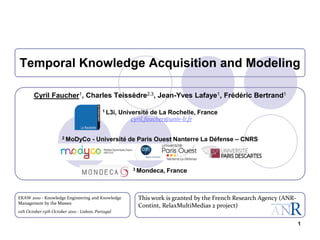Temporal Knowledge Acquisition and Modeling
- 1. 1 Temporal Knowledge Acquisition and Modeling This work is granted by the French Research Agency (ANR- Contint, RelaxMultiMedias 2 project) Cyril Faucher1, Charles Teiss¨¨dre2,3, Jean-Yves Lafaye1, Fr¨¦d¨¦ric Bertrand1 1 L3i, Universit¨¦ de La Rochelle, France cyril.faucher@univ-lr.fr 2 MoDyCo - Universit¨¦ de Paris Ouest Nanterre La D¨¦fense ¨C CNRS 3 Mondeca, France EKAW 2010 - Knowledge Engineering and Knowledge Management by the Masses 11th October-15th October 2010 - Lisbon, Portugal
- 2. Introduction ? Context: Leisure and cultural event programming (festival, theater, etc.) & opening dates and hours (restaurant, exhibition, museums) ? Contrib: Temporal Knowledge Acquisition and Modeling Chain ? From natural language expressions to controlled text 2 ? Facilitating the work of human operators for acquisition of temporal properties/knowledge about ¡°Access Periods¡± ? NLP & MDE techniques ? Natural Language Processing ? Model Driven Engineering Natural Language Expressions Temporal properties Controlled text As model Extraction / Generation NLP MDE Faucher et al 2
- 3. From Natural Language Expressions to Controlled text ? Natural language expressions ? (1) The museum is open every day except Tuesday and the following French holidays: December 25, January 1, May 1, and August 15. Opening hours: Monday, Thursday, Saturday, Sunday: from 9 a.m. to 6 p.m. Wednesday, Friday: from 9 a.m. to 10 p.m. ? (2) Opening times: Monday to Friday: Lunch (12 noon to 2 p.m.) Dinner (6.30 p.m. to 11 p.m.). Saturday: Dinner (6.30 p.m. to 11 p.m.) ? (3) Opened every day from 10:00 to 18:00, except Tuesdays. ? Controlled text (close to natural language) ? is constrained by a grammar ? can be interpreted by a machine Faucher et al 3
- 4. Temporal knowledge ? Temporal knowledge is expressed as a set of intensional expression ? Opening times: Monday to Friday: Lunch (12 noon to 2 p.m.) Dinner (6.30 p.m. to 11 p.m.). Saturday: Dinner (6.30 p.m. to 11 p.m.) ? Translation into extension for visualization/control tasks ? extension / concrete dates: closed on Sunday = closed Sunday 2010-09-19, closed Sunday 2010-09-26, closed Sunday 2010-10-03 Faucher et al 4
- 5. Detailed workflow Text input frame Faucher et al 5
- 6. Detailed workflow Text input frame Annotations Faucher et al 6 Automatic annotation (Unitex patterns) + post-treatment to lift ambiguities
- 7. Detailed workflow Text input frame Annotations Serialization in XMI/XML Faucher et al 7
- 8. Detailed workflow 8 Text input frame Annotations Serialization in XMI/XML Calendar editing Text / Calendar Synchronization
- 9. Detailed workflow Serialization in XMI/XML Linguistic Model Access Period domain populates Faucher et al 9
- 10. Detailed workflow Linguistic Model (specific to the domain of Access Period) Temporal Model (as a pivot) that extends ISO 19108 (generic to define temporal expressions) model transformation Textual representation conforms to the grammar defined in Xtext iCalendar export Temporal data in extension over a time span Faucher et al 10
- 11. Conclusions ? Workflow synthesis ? Future work ? Query engine (upon intensional expressions) Natural Language expressions Extraction/ Generation NLP Linguistic Model Controlled text Temporal Model MDE MDE iCalendar MDE Calendar entry auto creation, Visualization and editing Faucher et al 11











